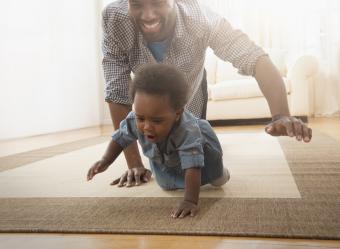
Movement milestones are always exciting moments in a parent's life, but sometimes it can feel like an eternity waiting for your little one to become mobile. When do babies start crawling? And how can help you teach them reach this important developmental milestone?
If you think your baby is nearing the crawling stage, we answer at what age they usually start, plus give you a list of easy activities to help them develop the skills and motivation to move!
When Do Babies Start Crawling?
On average, babies will usually start crawling between the ages of seven and ten months. However, every baby is different, and as annoying as that statement is, it could not be more true. I have one son who started crawling just before turning six months old and another who never really crawled until he started walking. Additionally, there are other infants, like preemies, who take a bit longer to gain this movement milestone.
What is important for new parents to know is that all of these scenarios are completely normal. According to the American Academy of Pediatrics, "as long as your baby is coordinating each side of her body and using each arm and leg equally, there's no cause for concern."
Signs Your Baby Is Ready to Crawl
Crawling involves a lot of coordination and strength, but once your baby starts to master these skills, he or she will be ready to start moving and grooving! Here are some hints that they might be on the move very soon.
- Constant movement while lying or sitting down
- This can include scooting while on their belly or bottom and flipping over or rolling.
- Rocking back and forth while on all fours
- Launching forward or backward while on all fours
Types of Crawls

New parents are usually looking for the traditional crawl where a baby is on their hands and knees and they move opposite arms and legs in unison. But the reality is that every crawling baby moves a bit differently.
While one child may crawl in the classic way, another may implement an army crawl, and still others may look like they are doing a crab walk.
Common crawling styles Include:
- Traditional Crawl
- For this crawl, your baby is on their hands and knees and they move one arm and the opposite leg in unison.
- Bear Crawl
- This involves your baby keeping their elbows and knees straight and walking like a bear.
- Army Crawl
- Babies who use this crawl style will make the same movements as the traditional and bear crawls, but their bellies stay on the floor and they will pull themselves forward with their arms.
- Crab Crawl
- As the name implies, this crawl looks a bit like a crab. Babies will typically move side to side or backwards, but sometimes they will move with one leg bent and the other extended.
- Rolling
- This was my son's favorite way to get around. Why use your hands when you can just roll from one spot to the next!
- Scooting
- Kids who love to sit and live in homes with tile or wood floors tend to take to this type of crawl. They will simply scoot while sitting on their bottom.
Babies can go through various types of crawls, such as rolling, then army crawling, and finally transitioning to the traditional crawl, or they can simply stick with one movement style.
Additionally, some babies will transition through the crawling stages within a few days and others can take weeks to months. Every stage and style will be unique to your baby.
When Should I Worry That My Baby Isn't Crawling?
There is no set timeline for when a baby has to start crawling, which means that there is likely no cause for concern.
However, if your child is trying to move, but they are only using one side of their body or the coordination of their arms and legs seems off and there is no improvement over time, it is always best to talk to your pediatrician.
6 Easy Ways to Encourage Crawling
If you want a crawling baby sooner rather than later, then you need to help your little one build up their strength and motivate them to move! Here are some simple ways to get this done.
1. Do Tummy Time Multiple Times a Day
Tummy time is essential for building up your baby's head and neck control as well as their shoulder, arm, and core strength. Best of all, you can start this activity from the day you get home from the hospital if your baby was born at term! This exercise is exactly what it sounds like — you allow your baby to spend time on their tummy.

THIS ACTIVITY SHOULD ALWAYS BE CLOSELY SUPERVISED.
Experts recommend starting with "two or three short (3- to 5-minute) tummy time sessions each day." Then, as your baby slowly starts to build up their stamina, you can begin longer and more frequent sessions. Your goal should be to reach 15 to 30 minutes of tummy time daily by the time your baby is two months old.
Avoid doing tummy time immediately after feedings. This can lead to your baby spitting up their meal. Additionally, if you want your baby to sleep through the night, consider making tummy time a part of your regular bedtime routine. I recommend starting with tummy time, followed by a relaxing bath, and then doing their last feeding for the night in a dim and quiet room.
2. Avoid Container Products
Swings, walkers, floor seats, bouncers, and even play pens will hinder your baby's ability to crawl. If you want a crawling baby, then you need to give the room and freedom to roam. Thus, create a safe baby play area that can give them the chance to try to out this skill. The more time they spend on the floor, the better off they will be!
3. Place Objects Just Out of Their Reach
Once your baby has solid head and neck control and can prop themselves up while on their belly, begin placing brightly colored toys just out of their reach. This can entice your little one to try to move closer in order to stake claim on this exciting item.
4. Show Them How It Is Done
Monkey see, monkey do! If you want your baby to crawl, another great motivator is to show them how it is done. Get on all fours and slowly crawl towards them, beside them, behind them, and around them. Let them watch your actions. Babies learn through observation and imitation, so this simple act can help them to better understand the process.
Since they need to pop up off their belly to engage in a traditional or bear crawl, consider also doing push ups in their view! This is another great skill to copy.

5. Create an Obstacle Course
As your little one slowly begins to move, a fun way to help improve their technique is to place obstacles in their path. This can include pillows, tunnels, foam rollers, empty boxes, and any other safe objects that you have lying around the house. Just remember to always supervise this type of play.
6. Praise, Praise, Praise
When your baby starts trying to crawl, get excited and let them know they are doing a great job! Positive reinforcement can be a great tool for helping your child gain new skills and get motivated to continue the activity.
Other Considerations for a Crawling Baby

Comfort and safety are key when it comes to crawling babies. Here are some important things to consider:
- Practice crawling on carpet, rugs, or cushioned play mats. This will be easier on their arms and knees.
- Dress your baby in long sleeve shirts and pants. This can facilitate scooting sooner and it further protects their limbs.
- Lose the socks. This allows their toes to grip onto the floor better.
- Get on your hands and knees and look around. Then, ask yourself, 'what needs to be babyproofed?'
- Top areas to consider are sharp edges on furniture and baseboards, outlets, and cords.
- Also, take the time to look under furniture. Has anything fallen underneath that could be poisonous or a choking hazard like button batteries or a silica gel packet?
- Put gates up to keep your baby in safe spaces — bathrooms and stairways are some dangerous areas to block off
Once They Start Moving, They Will Never Stop
Crawling is the first of many movement milestones. If your baby is showing signs that they may crawl soon, make babyproofing a priority. Also, be ready to watch them like a hawk. Once they start moving, there really isn't much of an off switch!







